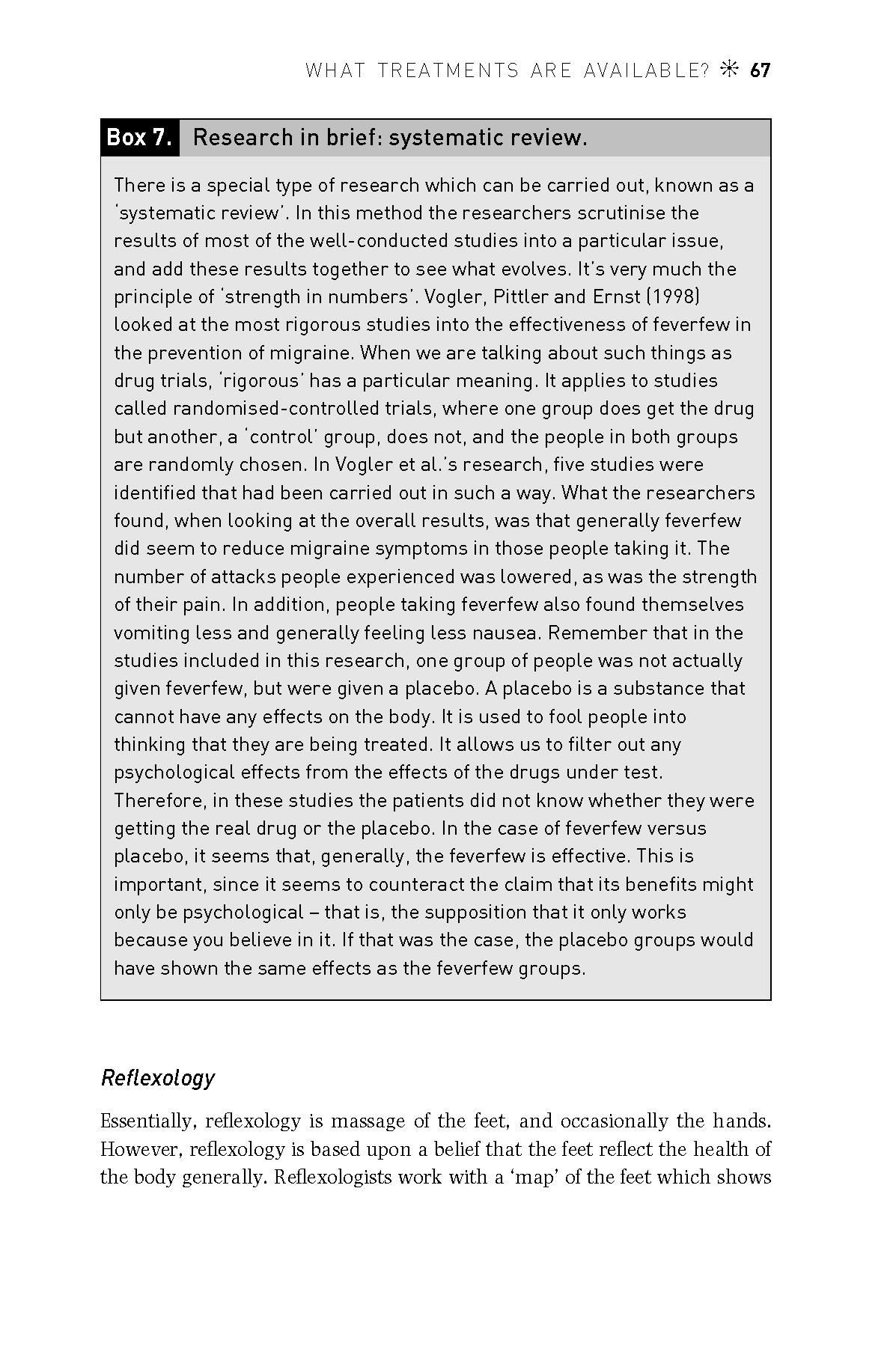UHAM084

WHAT TREATMENTS ARE AYAILABLE? * 67
Box 7.
Research in brief: systematic review.
There is a special type of research which can be carried out, known as a systematic review'. In this method the researchers scrutinise the results of most of the well-conducted studies into a particular issue, and add these results together to see what evolves. It's very much the principle of strength in numbers'. Vogler, Pittler and Ernst (1998) looked at the most rigorous studies into the effectiveness of feverfew in the prevention of migraine. When we are talking about such things as drug trials, rigorous' has a particular meaning. It applies to studies called randomised-controlled trials, where one group does get the drug but another, a control' group, does not, and the people in both groups are randomly chosen. In Vogler et al.'s research, five studies were identified that had been carried out in such a way. What the researchers found, when looking at the overall results, was that generally feverfew did seem to reduce migraine symptoms in those people taking it. The number of attacks people experienced was lowered, as was the strength of their pain. In addition, people taking feverfew also found themselves vomiting less and generally feeling less nausea. Rememberthat in the studies included in this research, one group of people was not actually given feverfew, but were given a placebo. A placebo is a substance that cannot have any effects on the body. It is used to fool people into thinking that they are being treated. It allows us to filter out any psychological effects from the effects of the drugs under test.
Therefore, in these studies the patients did not know whether they were getting the real drug or the placebo. In the case of feverfew versus placebo, it seems that, generally, the feverfew is effective. This is important, sińce it seems to counteract the claim that its benefits might only be psychological - that is, the supposition that it only works because you believe in it. If that was the case, the placebo groups would have shown the same effects as the feverfew groups.
Reflexology
Essentially, reflexology is massage of the feet, and occasionally the hands. However, reflexology is based upon a belief that the feet reflect the health of the body generally. Reflexologists work with a ‘map’ of the feet which shows
Wyszukiwarka
Podobne podstrony:
UHAM086 WHAT TREATMENTS ARE AYAILABLE? ^ 69 Pain redefinition is just a part of something called cog
UHAM088 WHAT TREATMENTS ARE AYAILABLE? * 71 stress or anxiety. In these cases, where the cause is ps
UHAM082 WHAT TREATMENTS ARE AYAILABLE? ^ 65Complementary therapies A wide rangę of complementary the
UHAM080 What treatments are available? This chapter deals with the morę common treatments, sińce the
UHAM090 WHAT TREATMENTS ARE AYAILABLE? * 73 the amount of placebo effect is what is important. Some
Scientific research in corporate financial liquidity & teaching at Wrocław University of Economi
UHAM032 WHO HAS HEADACHES AND M I G RAI N ES? ^ 15 profession are not exempt from this. There is a g
Blue System Greatest Hits(steel box collection)(inside) BLUE SYSTEM 9. My Bed Is T
Suzuki RM250 4 HOW TO USE THIS MANUAŁTO LOCATE WHAT YOU ARE LOOKING FOR: 1. The te
16719 productspage Do not remove this image unless you know what you are doing visit http://docs.get
17. What are the variou$ segment registers in 8086? Codę, Data, Stack, Extra Segme
5 5. What products are on sale in the family storę? a. clothes b.Tools c. Fruits, meats, eggs, sugar
p006 - Hm... What a strange scales thin, with some I moustaches. ■ - And I wonder,^ what f
skanuj0012 Name: ID: A I 121. Rewrite the question as an indirect question. What time are Mum and Da
więcej podobnych podstron